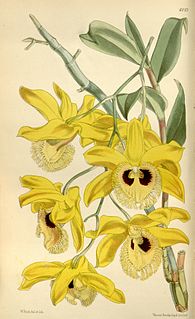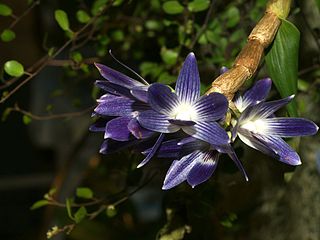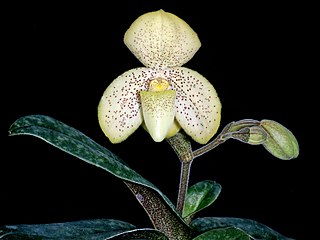| Image | Name | Distribution | Elevation (m) |
|---|
| Dendrobium angusticaule P.J.Spence 2016 | Papua New Guinea (Mussau Island) | |
 | Dendrobium antennatum Lindley 1843 | Queensland Australia, Papua and New Guinea, the Solomon Islands and surrounding islands | 0–1,200 metres (0–3,937 ft) |
 | Dendrobium archipelagense Howcroft & W.N.Takeuchi 2002 | Bismark Archipelago | 0–250 metres (0–820 ft) |
| Dendrobium aries J.J.Sm. 1914 | western New Guinea | 0 metres (0 ft) |
| Dendrobium bicaudatum Reinw. ex Lindl. 1859 | Mollucas, Sulawesi and the Philippines | 0–1,000 metres (0–3,281 ft) |
| Dendrobium brillianum Ormerod & Cavestro 2005 | Malesia (Papua New Guinea) | |
| Dendrobium burkeanum Ormerod 2009 | Indonesia | |
| Dendrobium busuangense Ames 1920 | Philippines (Busuang Island ) | 300 metres (980 ft) |
| Dendrobium calophyllum Rchb.f. 1870 | Java, Lesser Sunda Islands and the Moluccas | 0 metres (0 ft) |
 | Dendrobium canaliculatum R. Brown 1810 | Australia and New Guinea | 0–500 metres (0–1,640 ft) |
 | Dendrobium capra J.J. Sm. 1910 | Lesser Sunda Islands and eastern Java | |
 | Dendrobium carronii Lavarack & P.J. Cribb 1983 | Australia and Papua and New Guinea | 0–500 metres (0–1,640 ft) |
| Dendrobium cochliodes Schltr. 1912 | Papua and New Guinea and Irian Jaya | 400–1,600 metres (1,300–5,200 ft) |
| Dendrobium conanthum Schltr. 1912 | New Guinea, New Caledonia, the Philippines and Vanuatu | 0–800 metres (0–2,625 ft) |
| Dendrobium crispilinguum P.J.Cribb 1980 | Papua New Guinea | 1,100–1,600 metres (3,600–5,200 ft) |
| Dendrobium dedeksantosoi D.S.Santoso 2022 | Maluku Islands | |
| Dendrobium devosianum J.J.Sm. 1934 | western New Guinea | |
 | Dendrobium discolor Lindley 1841 | Australia | 0–550 metres (0–1,804 ft) |
| Dendrobium enigmaticum Ormerod 2009 | Papua New Guinea | |
| Dendrobium gouldii Rchb. f. 1867 | Papua and New Guinea and the Solomon Islands | 0–700 metres (0–2,297 ft) |
| Dendrobium hamiferum P.J.Cribb 1981 | New Guinea | 1,100–1,800 metres (3,600–5,900 ft) |
| Dendrobium helix P.J. Cribb 1980 | New Guinea | 0–150 metres (0–492 ft) |
| Dendrobium irinae Ormerod 2017 | New Guinea | |
| Dendrobium jennyanum Kraenzl. 1896 | New Guinea | |
| Dendrobium johannis Rchb.f 1865 | Australia and Papua and New Guinea | |
| Dendrobium lasianthera J.J. Sm 1932 | Papua and New Guinea | 0–100 metres (0–328 ft) |
| Dendrobium laxiflorum J.J.Sm. 1932 | Moluccas | |
| Dendrobium leporinum J.J.Sm. 1909 | the Mouluccas and western New Guinea | |
 | Dendrobium lineale Rolfe 1889 | New Guinea | 0–800 metres (0–2,625 ft) |
| Dendrobium macranthum A.Rich.1834 | New Caledonia, Santa Cruz Islands, Vanuatu and Wallis & Futna | 0–500 metres (0–1,640 ft) |
| Dendrobium magistratus P.J. Cribb 1981 | Papua and New Guinea | 1,300–1,500 metres (4,300–4,900 ft) |
| Dendrobium militare P.J.Cribb 1996 | Ternate of the Moluccas Islands | 1,500 metres (4,900 ft) |
 | Dendrobium mirbelianum Gaudich. 1829 | Queensland Australia, Solomon Islands and Papua and New Guinea | 0–650 metres (0–2,133 ft) |
| Dendrobium mussauense Ormerod 1997 | The Bismark Archipelago to the north of New Guinea | |
| Dendrobium odoardoi Kraenzl. 1910 | New Guinea. | |
| Dendrobium nindii W. Hill 1874 | northeastern Australia and sporadically in New Guinea | 0–200 metres (0–656 ft) |
| Dendrobium parnatanum Cavestro 2002 | Western New Guinea | 200 metres (660 ft) |
| Dendrobium percnanthum Rchb.f. 1886 | Moluccas | |
| Dendrobium pseudoconanthum J.J.Sm. 1926 | Sulawesi | |
| Dendrobium racieanum Cavestro 2003 | western New Guinea | 250 metres (820 ft) |
| Dendrobium rennellii P.J.Cribb 1983 | Solomon Islands | 0–100 metres (0–328 ft) |
| Dendrobium samoense P.J.Cribb 1983 | Samoa | 0–600 metres (0–1,969 ft) |
| Dendrobium schulleri J.J.Sm. 1914 | Papua (Noemfoor Island). | |
| Dendrobium soriense Howcroft 1996 | Papua New Guinea | |
| Dendrobium stockelbuschii Schettler 2016 | eastern Indonesia | |
| Dendrobium stratiotes Rchb. f.1886 | western New Guinea, the Moluccas [Halmaheira and Morotai], the Sunda Islands and Sulawesi | |
 | Dendrobium strebloceras Rchb.f 1886 | Malaysian archipelago | |
| Dendrobium strepsiceros J.J. Sm. 1912 | the Moluccas and New Guinea | 0–50 metres (0–164 ft) |
| Dendrobium sutiknoi P.O'Byrne 2005 | New Guinea | |
| Dendrobium sylvanum Rchb. f. 1877 | Papua New Guinea, New Ireland, Bouganville and the Solomons | 0–80 metres (0–262 ft) |
 | Dendrobium tangerinum P.J. Cribb 1980 | New Guinea | 0–1,250 metres (0–4,101 ft) |
 | Dendrobium taurinum Lindl. 1843 | Philippines | 0–300 metres (0–984 ft) |
| Dendrobium taurulinum J.J.Sm. 1920 | Seram of the Moluccas | |
| Dendrobium tokai Rchb.f. 1865 | Fiji and Tonga | 0–800 metres (0–2,625 ft) |
 | Dendrobium trilamellatum J.J.Sm. 1908 | southern New Guinea and in northern Australia | |
| Dendrobium violaceoflavens J.J. Sm. 1929 | western New Guinea | 0 metres (0 ft) |
| Dendrobium wulaiense Howcroft 1981 | Papua and New Guinea | |
|





























